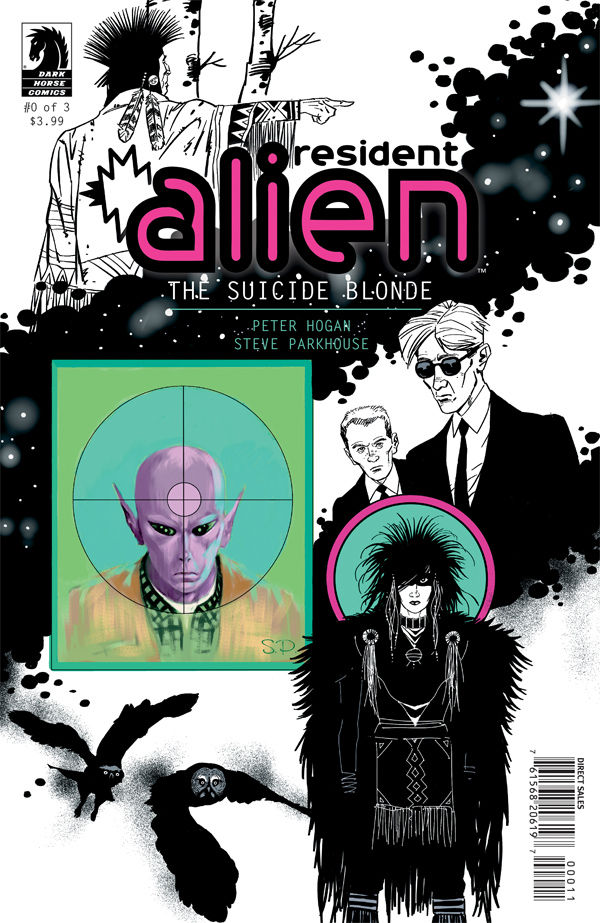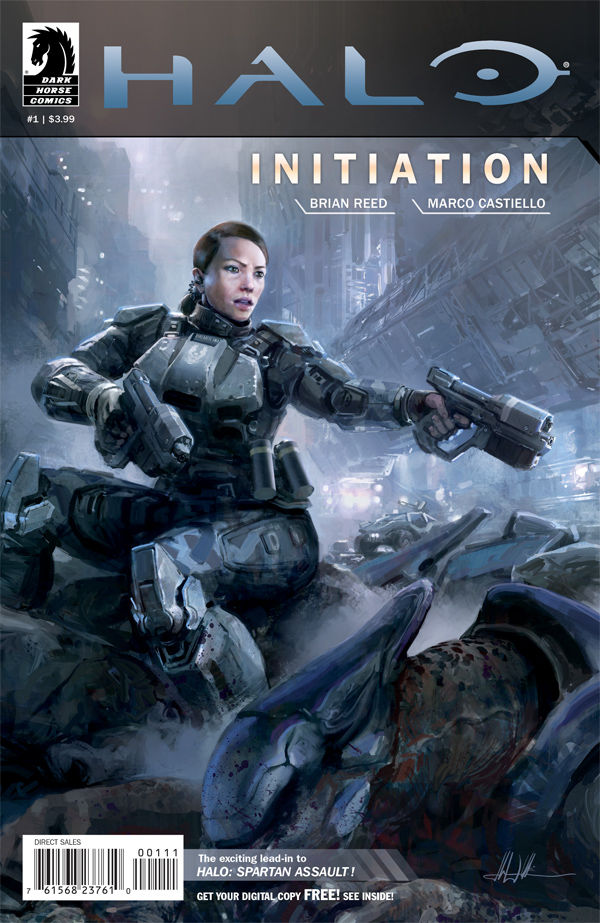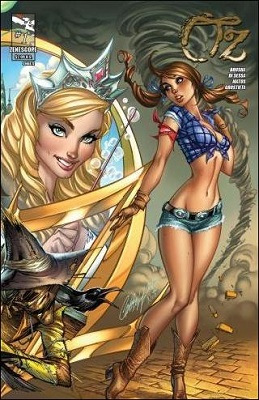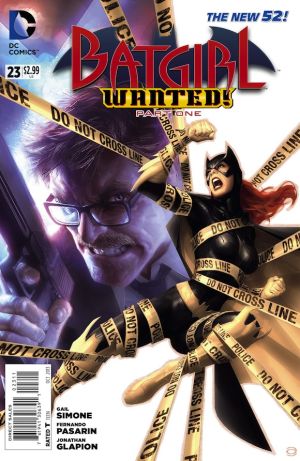We’re No. 1! is a weekly feature looking at first issues in new comic series, as well as one-offs and special releases. In his reviews, Jeff highlights stories with diverse characters and plot lines Geekquality readers can care about, as well as points out comics that miss the mark.
It’s good to be back, or at least that’s what I thought before I wandered into my local comic book shop this Wednesday. The shop itself is awesome (huge love to the guys who run Whatever Comics in SF) but majority of this week’s #1’s left much to be desired.
 First off, the good stuff. Dark Horse Comics puts out a regular anthology called Dark Horse Presents, and if you don’t read it, you should. It typically features short stories (if that’s a thing in comics), usually 5 pagers or so, several little bits of new stories that the company is developing. It’s a good way to build traction of a good series, and it’s spawned some amazing stuff (Michael Avon Oeming’s The Victories springs to mind). They’ve gone and done it again this week, collecting the first three chapters of Resident Alien: The Suicide Blonde which originally appeared in this anthology, and published them as one of my faves, an issue #0. This is obviously done with an eye to a regular series, and it’s an intriguing one. The plot centers around a marooned extra-terrestrial who calls himself Harry. While he waits for his buddies back home to come and find him, Harry is posing as one of us, mingling with the residents of the small western town of Patience, and even serving as their doctor. Harry looks pretty much like the typical Roswell type alien – big eyes, grey skin, pointy ears – but he manages to mask his appearance from the town folk. Interestingly, artist Steve Parkhouse draws Harry with his regular “alien” face, reminding the audience who he is, even if the townsfolk are fooled. Some might be more savvy than others, in particular a young Native American nurse named Asta, who has dreams of Harry’s true countenance. Harry, meanwhile, is intrigued by a series of local murders, including that of the town’s previous doctor, and he’s eager to help the police with is forensic analysis. How Harry got such an astute knowledge of human anatomy is left to the vagaries of science fiction, but his genuinely human behavior and ability to adapt make for a great approach to the immigration conversation. Harry is adapting to life in a new place, contributing his skills as best he can, making a life for himself and becoming a valued part of his community. Though it’s painfully obvious to the reader who he is, he must keep his differences a secret from the people who he is bringing into his life, despite the fact that those differences define him. The cast of the book is well rounded (i.e. even in a southwestern town like Patience, the book is not full of only white people) making the story feel like everyday America.
First off, the good stuff. Dark Horse Comics puts out a regular anthology called Dark Horse Presents, and if you don’t read it, you should. It typically features short stories (if that’s a thing in comics), usually 5 pagers or so, several little bits of new stories that the company is developing. It’s a good way to build traction of a good series, and it’s spawned some amazing stuff (Michael Avon Oeming’s The Victories springs to mind). They’ve gone and done it again this week, collecting the first three chapters of Resident Alien: The Suicide Blonde which originally appeared in this anthology, and published them as one of my faves, an issue #0. This is obviously done with an eye to a regular series, and it’s an intriguing one. The plot centers around a marooned extra-terrestrial who calls himself Harry. While he waits for his buddies back home to come and find him, Harry is posing as one of us, mingling with the residents of the small western town of Patience, and even serving as their doctor. Harry looks pretty much like the typical Roswell type alien – big eyes, grey skin, pointy ears – but he manages to mask his appearance from the town folk. Interestingly, artist Steve Parkhouse draws Harry with his regular “alien” face, reminding the audience who he is, even if the townsfolk are fooled. Some might be more savvy than others, in particular a young Native American nurse named Asta, who has dreams of Harry’s true countenance. Harry, meanwhile, is intrigued by a series of local murders, including that of the town’s previous doctor, and he’s eager to help the police with is forensic analysis. How Harry got such an astute knowledge of human anatomy is left to the vagaries of science fiction, but his genuinely human behavior and ability to adapt make for a great approach to the immigration conversation. Harry is adapting to life in a new place, contributing his skills as best he can, making a life for himself and becoming a valued part of his community. Though it’s painfully obvious to the reader who he is, he must keep his differences a secret from the people who he is bringing into his life, despite the fact that those differences define him. The cast of the book is well rounded (i.e. even in a southwestern town like Patience, the book is not full of only white people) making the story feel like everyday America.
 Most of the rest of this week’s new fare is just super-heroic ass-whoopin’ in one form or another, some better than the rest. Dark Horse gets in on the licensing game with HALO: Initiation #1, which is interestingly NOT a story about the enigmatically named Master Chief (the star of the HALO video game series). It focuses instead on Corporal Sarah Palmer, a tough as nails soldier in the … whatever, the HALO army? I admit, I don’t play the game, and that helps illustrate one flaw of the book. If you’re not already familiar with the games, there’s little here to draw you in. However, if HALO is your jam, then you’ll enjoy this high-action story of how Palmer proves her mettle and gets recruited to an elite unit known as “The Spartans”. Beyond that, all that’s left to be said is that it’s nice to see a comic book about a woman in battle armor.
Most of the rest of this week’s new fare is just super-heroic ass-whoopin’ in one form or another, some better than the rest. Dark Horse gets in on the licensing game with HALO: Initiation #1, which is interestingly NOT a story about the enigmatically named Master Chief (the star of the HALO video game series). It focuses instead on Corporal Sarah Palmer, a tough as nails soldier in the … whatever, the HALO army? I admit, I don’t play the game, and that helps illustrate one flaw of the book. If you’re not already familiar with the games, there’s little here to draw you in. However, if HALO is your jam, then you’ll enjoy this high-action story of how Palmer proves her mettle and gets recruited to an elite unit known as “The Spartans”. Beyond that, all that’s left to be said is that it’s nice to see a comic book about a woman in battle armor.
 Howard Chaykin’s (Black Kiss, Sattelite Sam) re-imagining of Buck Rogers brings out some tough female soldiers as well. This tale sticks to the basics, with Buck as a soldier who pulled a Rip Van Winkle and was awakened hundreds of years later to a highly advanced technological society where his soldierly skills can do some good. However, this version doesn’t include the outer space bits, instead setting Buck in an America that has fallen to pieces. Warring factions of the populace band together in clans and, with jet packs and pulse guns, fight each other for basic supplies and survival. The book has the feel of early pulp comics, when Buck Rogers was originally born. Rogers wears a leather jacket and looks more like the Rocketeer than a space man. He also espouses his beliefs that Americans should stop fighting among themselves and band together against the true enemy (in this case, the Chinese who invaded and destroyed America years earlier). There’s definitely a touch of racism in his anger, akin to the anger often expressed in WWII era tales towards the Japanese and the Germans. While the book has a certain war-time feel, it also feels dated. Meanwhile, Colonel Wilma Deering is a really well developed character in this newer version. She’s Buck’s superior officer, and refuses to let him forget it. While the character has been depicted since the original as Buck’s love interest, over the generations she’s developed a spunkiness and inner fortitude that’s born comparisons to Lois Lane. In the popular early 80’s TV series, she was depicted as cold and militaristic, but eventually warmed to Buck, all while wearing deep V-neck spandex. Despite the fashion trends of the future, Deering was a positive early role model for women in the military, serving as an accomplished pilot who often saved Buck, rather than the typical reverse. In Chaykin’s series, Deering continues her hard nosed military bearing, refusing to allow Buck to address her without her rank, and worrying more about proper ordinance care than romantic twists. She regards Buck as a loud mouth and loose canon, and sees her role in her clan as a leader. While this may change, her core strength isn’t likely to diminish in the care of a writer like Chaykin, and this series is worth following.
Howard Chaykin’s (Black Kiss, Sattelite Sam) re-imagining of Buck Rogers brings out some tough female soldiers as well. This tale sticks to the basics, with Buck as a soldier who pulled a Rip Van Winkle and was awakened hundreds of years later to a highly advanced technological society where his soldierly skills can do some good. However, this version doesn’t include the outer space bits, instead setting Buck in an America that has fallen to pieces. Warring factions of the populace band together in clans and, with jet packs and pulse guns, fight each other for basic supplies and survival. The book has the feel of early pulp comics, when Buck Rogers was originally born. Rogers wears a leather jacket and looks more like the Rocketeer than a space man. He also espouses his beliefs that Americans should stop fighting among themselves and band together against the true enemy (in this case, the Chinese who invaded and destroyed America years earlier). There’s definitely a touch of racism in his anger, akin to the anger often expressed in WWII era tales towards the Japanese and the Germans. While the book has a certain war-time feel, it also feels dated. Meanwhile, Colonel Wilma Deering is a really well developed character in this newer version. She’s Buck’s superior officer, and refuses to let him forget it. While the character has been depicted since the original as Buck’s love interest, over the generations she’s developed a spunkiness and inner fortitude that’s born comparisons to Lois Lane. In the popular early 80’s TV series, she was depicted as cold and militaristic, but eventually warmed to Buck, all while wearing deep V-neck spandex. Despite the fashion trends of the future, Deering was a positive early role model for women in the military, serving as an accomplished pilot who often saved Buck, rather than the typical reverse. In Chaykin’s series, Deering continues her hard nosed military bearing, refusing to allow Buck to address her without her rank, and worrying more about proper ordinance care than romantic twists. She regards Buck as a loud mouth and loose canon, and sees her role in her clan as a leader. While this may change, her core strength isn’t likely to diminish in the care of a writer like Chaykin, and this series is worth following.
 With all that, you might be wondering why I didn’t enjoy my trip to the comics shop this week. It all got ruined by Zenescope Comics, again, this time with Oz #1. Once again, their objectification of women, in this case the re-imagining of Dorothy Gale and the Witches of Oz, is frustrating because they are so close to writing a good story, but get lost in their artists’ need to depict every woman in the book nearly nude and sexualized. Dorothy, stuck in a Kansas that bores her nearly to death, here is depicted in the shortest cutoffs in history, pig-tails, and a tightly clinging, midriff baring plaid shirt. The Wicked Witch, who appears to reclaim her giant wolf-dog (Zenescope’s version of Toto, bearing some sort of secret weapon form Oz), is drawn like Elvira with less coverage. She sends Dorothy, the hotly contested dog and the whole farmhouse off in a tornado that, realistically, would have ripped to shreds the black cocktail napkin she’s wearing as a dress. (I’m surprised the Zenescope artists didn’t try it, frankly.) What makes this all so frustrating is that it’s a story almost entirely populated by women, as most Zenescope books in their Grimm Universe are, and most of them are intelligent and capable. Dorothy herself saves her male friend from a rampaging bull when a red shirt from the laundry blows into the pen. No one argues with depicting strong women as beautiful, or even using elements of femininity and sexuality as strengths, but that’s never what Zenescope does, and they’ve really outdone themselves with their various alternate covers. One depicts Dorothy seductively untying her skimpy farm girl top. (Perhaps to put on something more appropriate? Nah.) A second cover shows Dorothy and the Witch rubbing oil into a particularly buff Tin-Man (who doesn’t appear in the book at all yet). The third shows Dorothy as a flight attendant on a plane ride filled with Oz characters, with the Witch using her broom to raise Dorothy’s skirt for a flash of G-string. This kind of vile objectification, frankly, makes me not want to let my daughters read comics.
With all that, you might be wondering why I didn’t enjoy my trip to the comics shop this week. It all got ruined by Zenescope Comics, again, this time with Oz #1. Once again, their objectification of women, in this case the re-imagining of Dorothy Gale and the Witches of Oz, is frustrating because they are so close to writing a good story, but get lost in their artists’ need to depict every woman in the book nearly nude and sexualized. Dorothy, stuck in a Kansas that bores her nearly to death, here is depicted in the shortest cutoffs in history, pig-tails, and a tightly clinging, midriff baring plaid shirt. The Wicked Witch, who appears to reclaim her giant wolf-dog (Zenescope’s version of Toto, bearing some sort of secret weapon form Oz), is drawn like Elvira with less coverage. She sends Dorothy, the hotly contested dog and the whole farmhouse off in a tornado that, realistically, would have ripped to shreds the black cocktail napkin she’s wearing as a dress. (I’m surprised the Zenescope artists didn’t try it, frankly.) What makes this all so frustrating is that it’s a story almost entirely populated by women, as most Zenescope books in their Grimm Universe are, and most of them are intelligent and capable. Dorothy herself saves her male friend from a rampaging bull when a red shirt from the laundry blows into the pen. No one argues with depicting strong women as beautiful, or even using elements of femininity and sexuality as strengths, but that’s never what Zenescope does, and they’ve really outdone themselves with their various alternate covers. One depicts Dorothy seductively untying her skimpy farm girl top. (Perhaps to put on something more appropriate? Nah.) A second cover shows Dorothy and the Witch rubbing oil into a particularly buff Tin-Man (who doesn’t appear in the book at all yet). The third shows Dorothy as a flight attendant on a plane ride filled with Oz characters, with the Witch using her broom to raise Dorothy’s skirt for a flash of G-string. This kind of vile objectification, frankly, makes me not want to let my daughters read comics.
 Thankfully, there are so many other good examples of the right way to go, and this week’s honorable mention is one of the best of late. Frankly, there are a ton of great mainstream books addressing women and people of color these days, but this week’s best is Gail Simone’s work in Batgirl #23. Barbra Gordon has reclaimed the name since DC’s New 52 reboot two years ago, and Simone has turned her into a woman of finely balanced strength and emotional vulnerability. Her conversion from the paraplegic font of information known as Oracle and return to the cape and cowl have never been fully explained. We know that in her rebooted from the Joker shot her (that seminal moment from The Killing Joke graphic novel is so integral to the character DC wouldn’t dare mess with it), and we know someone healed her, and that it wasn’t easy. Barbra treats her body, and her role as Batgirl, as a precious thing. It’s a source of power for her, but also something that can be taken away from her, painfully. She knows she can be broken, and she’s more protective of herself and the people of Gotham than any current member of the Bat family, including Bruce himself. Meanwhile, her personal world has been destroyed more painfully than she could imagine. Her violent, unstable brother’s death at her own hands has for the first time put her in direct conflict with her father, Police Commissioner James Gordon. This destruction of her family, and her own self-doubt over violating the one rule of the Bat (no killing) has her as internally broken as her body once was, and she’s holding it together in such a tenuous way that even she doesn’t realize how messed up she might really be. There are also so many other personal dynamics in this book, it’s easy to forget it’s still a capes and spandex caper.
Thankfully, there are so many other good examples of the right way to go, and this week’s honorable mention is one of the best of late. Frankly, there are a ton of great mainstream books addressing women and people of color these days, but this week’s best is Gail Simone’s work in Batgirl #23. Barbra Gordon has reclaimed the name since DC’s New 52 reboot two years ago, and Simone has turned her into a woman of finely balanced strength and emotional vulnerability. Her conversion from the paraplegic font of information known as Oracle and return to the cape and cowl have never been fully explained. We know that in her rebooted from the Joker shot her (that seminal moment from The Killing Joke graphic novel is so integral to the character DC wouldn’t dare mess with it), and we know someone healed her, and that it wasn’t easy. Barbra treats her body, and her role as Batgirl, as a precious thing. It’s a source of power for her, but also something that can be taken away from her, painfully. She knows she can be broken, and she’s more protective of herself and the people of Gotham than any current member of the Bat family, including Bruce himself. Meanwhile, her personal world has been destroyed more painfully than she could imagine. Her violent, unstable brother’s death at her own hands has for the first time put her in direct conflict with her father, Police Commissioner James Gordon. This destruction of her family, and her own self-doubt over violating the one rule of the Bat (no killing) has her as internally broken as her body once was, and she’s holding it together in such a tenuous way that even she doesn’t realize how messed up she might really be. There are also so many other personal dynamics in this book, it’s easy to forget it’s still a capes and spandex caper.
Thanks for reading (and being patient while I was away last week). Upcoming weeks promise to be interesting, especially in September, when DC will launch 53 new #1 issues as their entire line is taken over for “Villains Month”, a company wide series of one shots.

